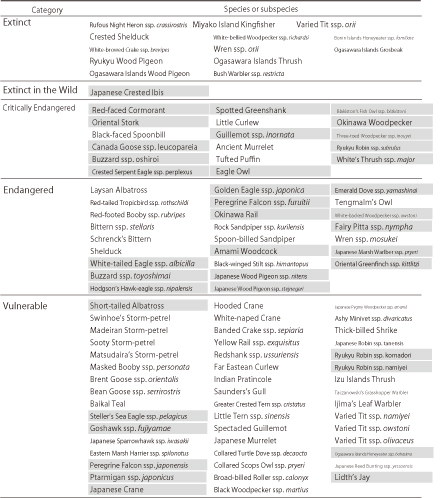Research
Grant-in-Aid for Scientific Research (Specially Designated Research Promotion)
Research on survival and recovery of rare birds (2001 - 2004)
Yamashina Institute has started the "Research for survival and recovery of rare birds" since 2003. All divisions of the Institute will take part in this broad project. Head of the research group, Satoshi Yamagishi gives a general outline of the research project.
(From October 1, 2002 issue of the newsletter Yamashina Choken News)
Aim of Research
According to fossil records which indicates the average span of a species' life to be roughly two million years, approximately one bird species should have been getting extinct every two hundred years in the avian world. However, this situation has changed drastically after the appearance of humans. During the last 400 years since 1600, we have lost 128 species of birds forever. This is approximately 60 times the extinction rate which took place in geological scale.
We have not identified the direct cause of extinction for all of the 128 species, but among the direct causes that were identified, human activities counted for all extinctions, with human introduced species counting for 39 percent, habitat destruction 36 percent, and hunting 23 percent. This increased rate of extinction is predicted to accelerate. According to the 2000 Red Data Book of IUCN, there could be over 450 bird extinctions by 2100 (See Figure).

Future extinction trajectory of threatened birds for the next hundred years.
This does not include additional species becoming threatened over time (from Birdlife International 2000)
In August 2002, Japan's Ministry of the Environment published the avian version of the Red Data Book, "Revised Edition of Endangered Wildlife Species in Japan" (See Table). Among the extinct 13 species and subspecies, some of which have strong relations to the Yamashina Institute, such as the Crested Shelduck Tadorna cristata and the Miyako Kingfisher Halcion miyakoensis are included. The subspecies Daito Bush Warbler Cettia diphone restricta needs further research because there are possibilities of its existence. The increase in numbers of Short-tailed Albatrosses Diomedea albatrus and the Red-crowned Cranes Grus japonensis, reflecting the efforts of certain people, lead to the change in status to "Endangered" from which they were stated as "Highly endangered" in the 1991 Red Data book category. This fact shows the importance of research and recovery programs. But still, the numbers of bird species on the list is overwhelmingly large.
>> Please click to see the table with pdf file

Red list category of Japanese birds
This table indicates only species that are endangered or higher in category, with the masked species also stated as [rare wildlife species] in the endangered species act (From Environment Agency, Japan 2002).
In this circumstance, the social task for the Yamashina Institute to protect rare bird species is greater than ever. So, we have started the "Research for survival and recovery of rare birds" in 2001 with the Grant-in-aid for Scientific Research (Specially Designated Research Promotion) from the Ministry of Education, Culture, Sport, Science and Technology. This Research is intended to identify the causes of change in avian population in a global environmental perspective to a local habitat scope of view. The research will be conducted in community scale, population scale, individual scale and also in molecular scale. We have formed four research groups to achieve our aims, and also formed a general management team consisting from outside experts for review and evaluation over the whole project.
Head of the Research Group : Satoshi Yamagishi, Director General, Yamashina Institute for Ornithology
(From October 1, 2002 issue of the newsletter Yamashina Choken News)

